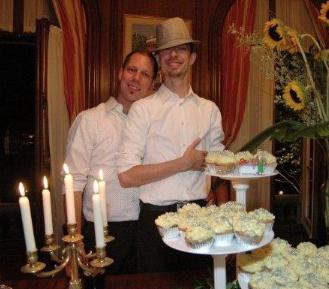New Statistics Canada census data released Sept 19 show that between the 2006 census and 2011, while the number of traditional families declined, the number of married same-sex couples nearly tripled.
Same-sex married couples make up just 0.8 percent of all married couples in Canada, but this is up 42 percent since 2006.
Same-sex marriage was legalized in 2005, just before the 2006 census — 13,550 same-sex couples got married between 2006 and 2011.
Common-law same-sex couples also increased 15 percent between 2006 and 2011, slightly more than the average overall increase of 13.8 percent for common-law couples.
Whether married or common-law, 55 percent of the same-sex couples recorded in the census data are male.
Kevin McCoy checked the “spouse” box next to his husband, Gilles Mercier’s, name in last year’s census.
“Who says the world can’t change for good?” he says, recalling his “dream day come true.” Married in 2007, the couple is one of nearly 4,500 same-sex married couples who live in Montreal.
Same-sex couples tend to be younger than the average Canadian couple. One quarter are younger than 34 — not even a fifth of straight couples get married around that age — while just more than six percent of same-sex couples are 65 and older.
Lesbian couples are significantly more likely than gay male couples to have children: 17 percent of female same-sex couples have kids, compared to only three percent of male couples.
Overall, the percentage of same-sex couples who are parents shot up by 181.5 percent since the last census – 9.4 percent of same-sex couples now have kids, compared to 47.2 percent of straight couples.
Egale executive director Helen Kennedy says the increasing number of same-sex families with children should push provinces to ensure their schools are safe for students from queer families.
“Youth with same-sex parents are being sexually and physically harassed or assaulted about the sexual orientation of their parents and their own perceived sexual orientation or gender identity,” Kennedy says. “With such a dramatic increase of same-sex couples with children, we need to address these issues within our education system.”
Kennedy hopes that these numbers act as a “wake-up call to our government.” She says the rise in stable same-sex households should push governments to introduce legislation to “make it easier for more same-sex couples to have children.”
The census also shows that queer couples are on the move.
Half of same-sex couples lived in Toronto, Montreal and Vancouver in 2006. That number dropped by nearly 10 percent in this census, suggesting that some same-sex couples are migrating outside the big three gay villages.
Well, maybe.
According to Statistics Canada, there may have been a little hiccup.
It seems that some of Canada’s more complex living situations may have thrown off the number of same-sex couples living in Canada by as much as 4,500.
Census manager Marc Hamel told Xtra that some of those “complicated” living situations might have caused Statistics Canada to count some straight roommates among their queer couples.
Hamel provides a hypothetical. If there are two men living together in a secondary household — a work camp in Alberta, say — and the census respondent lists them as married, then Statistics Canada’s algorithm may have decided that they’re married to each other, when, in fact, they’re both married to women back home. That situation was never supposed to occur, as respondents are supposed to fill out census forms from their primary residences — the ones where their spouses reside.
That caused Statistics Canada to attach a note of caution to the data. And because some regional data, especially in Alberta and Saskatchewan, might be skewed, there will be no breakdown of census data about same-sex couples outside Montreal, Toronto and Vancouver.
But there’s no need to worry, Hamel says. The same conclusion can be drawn either way — more same-sex couples are getting married in Canada.
“The magnitude may be different, but the trend is the same,” he says.
But there’s another caveat that could affect the magnitude of that trend. In 2006, same-sex marriage had only just been legalized. As such, there was no checkbox for “same-sex spouse,” only “same-sex common law.” Respondents would have had to enter that data voluntarily on a line marked “specify.” The option to report a same-sex spouse was introduced in 2011.
While those two little wrinkles may have thrown off the data by a percentage point or two, at least there’s no need to worry about the changes to the census, Hamel says.
He says that there was an “excellent response nationally” and that the data was “not impacted by the changing census.”
Ahead of the 2011 census, the Conservative government moved to axe the mandatory long-form version, with one Tory minister even whipping out Pierre Trudeau’s iconic “The state has no place in the bedrooms of the nation” quote to defend the decision.
Hamel says the mandatory short-form version gave Statistics Canada all the data it needed to chart the changing landscape of Canadian families.


 Why you can trust Xtra
Why you can trust Xtra


